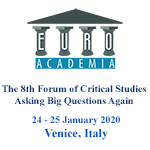Euroacademia Conferences
 Europe Inside-Out: Europe and Europeanness Exposed to Plural Observers (9th Edition) April 24 - 25, 2020
Europe Inside-Out: Europe and Europeanness Exposed to Plural Observers (9th Edition) April 24 - 25, 2020 Identities and Identifications: Politicized Uses of Collective Identities (9th Edition) June 12 - 13, 2020
Identities and Identifications: Politicized Uses of Collective Identities (9th Edition) June 12 - 13, 2020 8th Forum of Critical Studies: Asking Big Questions Again January 24 - 25, 2020
8th Forum of Critical Studies: Asking Big Questions Again January 24 - 25, 2020 Re-Inventing Eastern Europe (7th Edition) December 13 - 14, 2019
Re-Inventing Eastern Europe (7th Edition) December 13 - 14, 2019 The European Union and the Politicization of Europe (8th Edition) October 25 - 26, 2019
The European Union and the Politicization of Europe (8th Edition) October 25 - 26, 2019 Identities and Identifications: Politicized Uses of Collective Identities (8th Edition) June 28 - 29, 2019
Identities and Identifications: Politicized Uses of Collective Identities (8th Edition) June 28 - 29, 2019 The European Union and the Politicization of Europe (7th Edition) January 25 - 26, 2019
The European Union and the Politicization of Europe (7th Edition) January 25 - 26, 2019 7th Forum of Critical Studies: Asking Big Questions Again November 23 - 24, 2018
7th Forum of Critical Studies: Asking Big Questions Again November 23 - 24, 2018 Europe Inside-Out: Europe and Europeanness Exposed to Plural Observers (8th Edition) September 28 - 30, 2018
Europe Inside-Out: Europe and Europeanness Exposed to Plural Observers (8th Edition) September 28 - 30, 2018 Identities and Identifications: Politicized Uses of Collective Identities (7th Edition) June 14 - 15, 2018
Identities and Identifications: Politicized Uses of Collective Identities (7th Edition) June 14 - 15, 2018
“YOLOCAUST: You Only Live Once.” Holocaust and New Form of Representation
-
-

-
Presentation speakers
- Eirene Campagna, International University of Languages and Media, Milan, Italy
Abstract:
In 2017, Shahak Shapira wrote: “Dear Internet, last week I launched a project called YOLOCAUST that explored our commemorative culture by combining selfies from the Holocaust Memorial in Berlin with footage from Nazi extermination camps. The selfies were found on Facebook, Instagram, Tinder and Grindr. Comments, hashtags and Likes that were posted with the selfies are also included.” Indeed, since the Nineties Berlin has become the public space for several monuments and memorials to commemorate the extermination of the Jews. Some of those are: Eisenmann’s memorial or the Liebskind’s museum, Platform 17 (a railway station in the Grunewald district of Berlin), and many more in the whole city. However, it happens that tourists or visitors don’t know the real nature of these monuments and this phenomenon is explained by Shahak Shapira in his project. It is a website, which collected pictures on social networks, such as Facebook or Instagram, taken inside the Berlin Memorial to the Murdered Jews of Europe, and it transformed them into gifs. In the animated image, at first appears the original shot, then the background is replaced by pictures showing dead bodies and concentration camps. In this paper, starting from Yolocaust, I intend to analyse the relationship between Holocaust and new forms of representation. At the same time, through this analyse I’d like to observe the perception of the Holocaust in the society, especially in the post-memory era.
-
Related Presentations

Enlightenment Reloaded: How to Become Better as Individuals and Humankind?
- Sandra Eleonore Johst













